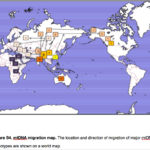
World Science en Route from Out-of-Africa to Out-of-America: First Stop is Out-of-Asia
bioRxiv doi: https://doi.org/10.1101/101410 Yuan, Dejian, Xiaoyun Lei, Yuanyuan Gui, Zuobin Zhu, Dapeng Wang, Jun Yu, and Shi Huang Modern Human Origins: Multiregional Evolution of Autosomes and East Asia Origin of Y and mtDNA Recent studies have established that genetic diversities are mostly maintained…
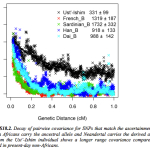
Ancient Ust’-Ishim DNA as Seen From the Americas
Nature 514, 445–449 (23 October 2014) doi:10.1038/nature13810 Genome sequence of a 45,000-year-old modern human from western Siberia Qiaomei Fu, Heng Li, Priya Moorjani, Flora Jay, Sergey M. Slepchenko, Aleksei A. Bondarev, Philip L. F. Johnson, Ayinuer Aximu-Petri, Kay Prufer, Cesare de Filippo,…
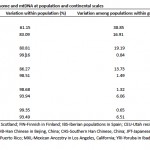
Molecular Variance Across Genetic Systems in Modern Humans and Their Kinship Structures
Gisele Horvat has kindly pointed me to this new pre-print. This post is cross-posted at www.kinshipstudies.org. Global patterns of sex-biased migrations in humans Chuan-Chao Wang, Li Jin, Hui Li. Abstract A series of studies have revealed the among-population components of…
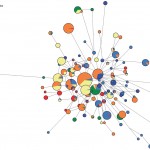
Y-DNA hg C3* in South America and Putative Ancient Transpacific Contacts
PLoS Genet 9(4): e1003460. doi:10.1371/journal.pgen.1003460 Continent-Wide Decoupling of Y-Chromosomal Genetic Variation from Language and Geography in Native South Americans Lutz Roewer, Michael Nothnagel, Leonor Gusmão, Veronica Gomes, Miguel González, Daniel Corach, Andrea Sala, Evguenia Alechine, Teresinha Palha, Ney Santos, Andrea…
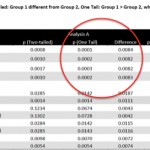
Archaic Admixture in Africa, a Final Solution for Cultural Anthropology and the New World Roots of the Oldest Dog: News from Around the Web
I haven’t been blogging for a while because of a new demanding leadership job. It will keep me busy, so I’m shifting to more of a bite-size blog post format. In the meantime, I’ve been active on Gisele Horvat’s Human…
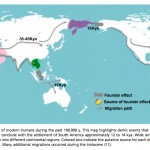
Out-of-Africa as Ghost Science
PNAS doi: 10.1073/pnas.1212380109 The Great Human Expansion Brenna M. Henn, Luca L. Cavalli-Sforza, and Marcus W. Feldman Genetic and paleoanthropological evidence is in accord that today’s human population is the result of a great demic (demographic and geographic) expansion that…

The Diversity of Tasmanian Languages
Proceedings of the Royal Society, B Biological Sciences, 2012 DOI: 10.1098/rspb.2012.1842 The Riddle of Tasmanian Languages Claire Bowern Recent work which combines methods from linguistics and evolutionary biology has been fruitful in dis- covering the history of major language families…
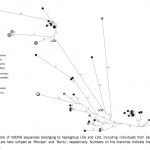
Intense Admixture: Khoisan Clicks and Khoisan Genes in Southeastern Bantu
European Journal of Human Genetics 2012, 1-7 DOI:10.1038/ejhg.2012.192 Genetic Perspectives on the Origin of Clicks in Bantu Languages from Southwestern Zambia Chiara Barbieri, Anne Butthof, Koen Bostoen, and Brigitte Pakendorf Some Bantu languages spoken in southwestern Zambia and neighboring regions…
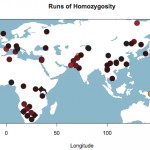
Clicks and Genes: Linguistic and Genetic Perspectives on Khoisan Prehistory
Science DOI: 10.1126/science.1227721 Genomic Variation in Seven Khoe-San Groups Reveals Adaptation and Complex African History Carina M. Schlebusch, Pontus Skoglund, Per Sjödin, Lucie M. Gattepaille, Dena Hernandez, Flora Jay, Sen Li, Michael De Jongh, Andrew Singleton, Michael G. B. Blum,…
Typological Linguistics and Population Genetics: A Synthesis or a Controversy
Trends in Cognitive Sciences Vol 16, Issue 3, March 2012, Pages 167–173 http://dx.doi.org/10.1016/j.tics.2012.01.007 Tools from Evolutionary Biology Shed New Light on the Diversification of Languages Stephen C. Levinson, and Russell D. Gray Computational methods have revolutionized evolutionary biology. In this paper…
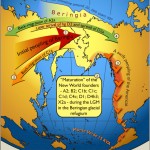
Dene-Yeniseian Language Family: Evidence for a Back-Migration to the Old World?
The 2012 Dene-Yeniseian Workshop took place on March 24 at the University of Alaska Fairbanks. Since the seminal presentation by the West Washington University linguist, Edward Vajda, of morphological and lexical evidence relating the small Yeniseian language family from Western…
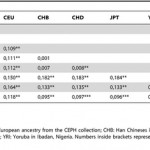
The Xavante Indians and Genetic Divergence Between American Indians and Africans
PLoS ONE 7 (8): e42702. doi:10.1371/journal.pone.0042702 Genome-Wide Analysis in Brazilian Xavante Indians Reveals Low Degree of Admixture Patricia C. Kuhn, Andréa R. V. Russo. Horimoto, José Maurício Sanches, João Paulo B. Vieira Filho, Luciana Franco, Amaury Dal Fabbro, Laercio Joel…
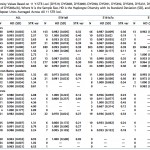
Genetics and Linguistics of the Bantu Expansion
Proc. Roy. Soc. Lond. B 279: 3256-3263. doi: 10.1098/rspb.2012.0318 Bringing Together Linguistic and Genetic Evidence to Test the Bantu Expansion De Filippo, Cesare, Koen Bostoen, Mark Stoneking, and Brigitte Pakendorf. The expansion of Bantu languages represents one of the most momentous…

Social Anthropology and the Bantu Expansion
Razib is now officially a fantasy science blogger. When he recently called his readers “stupid, ignorant or lazy” and put up a stringent comments policy (I bet inspired by my own) rallying them to show their “A-game,” I knew it…
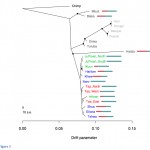
Khoisans Are Genetically Admixed and Not Basal to Other Humans, Hadza Are Recently Admixed
In my last post I discussed the ways in which phylogenetic trees constructed on the basis of genetic data confound population relationships derived from common descent and from admixture. Unless admixture is taken into account, the sampled populations may end…

How to Interpret Patterns of Genetic Variation? Admixture, Divergence, Inbreeding, Cousin Marriage
Two different but important population genetics papers have come out. One is Steven Bray et al. (2010) “Signatures of Founder Effects, Admixture, and Selection in the Ashkenazi Jewish Population.” The other one is Isabel Alves et al. (2012) “Genomic Data…

Howler Monkeys, Neandertals, Pygmies, Khoisans and More: Society for Molecular Biology and Evolution 2012
As I write, Society for Molecular Biology and Evolution (SMBE) is conducting its annual meetings in Dublin, Ireland. Dienekes has many useful pullouts from the available abstracts. I will make short comments on a few of them, plus bring in…

The Pygmy Enigma: Biology, Population Genetics and Linguistics
PLoS Genetics 8 (4): e1002641. doi:10.1371/journal.pgen.1002641 Patterns of Ancestry, Signatures of Natural Selection, and Genetic Association with Stature in Western African Pygmies Jarvis, Joseph P., Laura B. Scheinfeldt, Sameer Soi, Charla Lambert, Larsson Omberg, Bart Ferwerda, Alain Froment, Jean-Marie Bodo,…
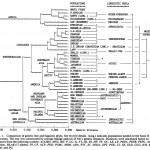
Phonemic Diversity and out-of-Africa Again: The Myth is Gaining a Momentum
PLoS ONE 7(4): e35289. doi:10.1371/journal.pone.0035289 Dating the Origin of Language Using Phonemic Diversity Perreault, Charles, and Sarah Mathew. Abstract Language is a key adaptation of our species, yet we do not know when it evolved. Here, we use data on…
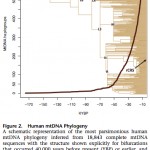
Between Behar et al. 2012 and Johnson et al. 1983: The Mitochondrial DNA Tree Comes of Age but Remains a Blunt Tool for Human Evolutionary History
American Journal of Human Genetics, Volume 90, Issue 4, 675-684, 6 April 2012 doi:10.1016/j.ajhg.2012.03.002 A “Copernican” Reassessment of the Human Mitochondrial DNA Tree from its Root Behar, Doron M., Mannis van Oven, Saharon Rosset, Mait Metspalu, Eva-Liis Loogvali, Nuno M….

The Effect of Long-Term Endogamy on Identity-By-Descent
PLoS ONE 7(4): e34267. doi:10.1371/journal.pone.0034267 Cryptic Distant Relatives Are Common in Both Isolated and Cosmopolitan Genetic Samples Henn, Brenna M., Lawrence Hon, J. Michael Macpherson, Nick Eriksson, Serge Saxonov, Itsik Pe’er, Joanna L. Mountain. Although a few hundred single nucleotide…
Piraha Indians, Recursion, Phonemic Inventory Size and the Evolutionary Significance of Simplicity
Daniel Everett has a new book out that will surely stir more controversy around Piraha Indians, Chomskyan recursion and the evolution of human language. I haven’t read this book yet, but The Chronicle of Higher Education has an extensive coverage…
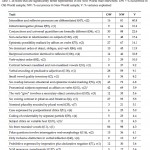
American Indian Uniqueness: Linguistics and Genetics
Journal of Linguistic Relationship 5 (2011): 130-134. Similarities among Languages of the Americas: An Exploration of the WALS Evidence Wichmann, Søren, Eric W. Holman, Dietrich Stauffer, and Cecil H. Brown. Abstract. An exploration of WALS (i.e. the World Atlas of…
Are American Indian Populations Subject to Sampling Bias in Human Origins Research?
The latest post by Dienekes re-kindled an observation that I wanted to make for a long time. Dienekes applied TreeMix software to ADMIXTURE components derived from HapMap-3 populations and created a tree with Sub-Saharan, East African, Northwest African, Gedrosia, Southwest…
Admixture: An Amerindian Component in Eurasian Populations
About a year ago, one of genome bloggers, Diogenes, discovered, using ADMIXTURE, an intriguing “Amerindian” component in a wide range of East and West Eurasian populations. Here are the results of his ADMIXTURE runs. Grey represents the component that’s modal…
Neanderthals and Amerindians: Intragroup Genetic Diversity and Population Size
John Hawks writes: “Neandertals have strikingly limited genetic variation. They once lived across a range from Spain to Siberia. Yet when we compare sequences across their whole genomes, we find them to be much less different across this geographic range…


Recent Comments